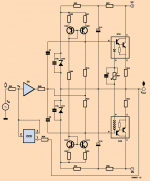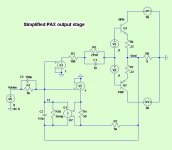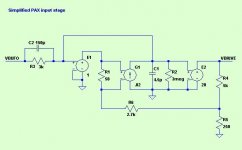Hi
I was reading Vitus Amplifier SS-101 specifications. It was written "Zero feedback". I look up this forum and found this thread
http://www.diyaudio.com/forums/showthread.php?threadid=10876
There, everybody had claimed the feedbacks are Local.
But in Elektor Magazine Apr-2008 an amplifier has been described which does not uses feedback, instead using an Error correction method. The designer is a very nice guy that you can ask your questions from him in Elektor forum. (here: http://www.elektor.com/forum/elekto...rticles/invitation-to-discussion.432667.lynkx)
1- I do Not know, How the quality will be. Maybe U experts can foresee!
I have extracted the pages from the magazine here for you.
http://www.4shared.com/file/60807816/187af4ea/PaX.html
2- What do you think about the voltage amplifier Stage. It uses The Supply current to Amplify the Input voltage;
3- Here Some Info about Vitus Amp SS-101. They claim:
"We do not employ any form of negative feedback. This is one of the really hot topics amongst different manufacturers, and most seem to be in favor of using feedback.
http://www.ultraaudio.com/features/2006_10_01.htm
Do you think Vitus is using the same Topology as Pax? If Not, What do U think?
ThanX
Shahriar
I was reading Vitus Amplifier SS-101 specifications. It was written "Zero feedback". I look up this forum and found this thread
http://www.diyaudio.com/forums/showthread.php?threadid=10876
There, everybody had claimed the feedbacks are Local.
But in Elektor Magazine Apr-2008 an amplifier has been described which does not uses feedback, instead using an Error correction method. The designer is a very nice guy that you can ask your questions from him in Elektor forum. (here: http://www.elektor.com/forum/elekto...rticles/invitation-to-discussion.432667.lynkx)
1- I do Not know, How the quality will be. Maybe U experts can foresee!
I have extracted the pages from the magazine here for you.
http://www.4shared.com/file/60807816/187af4ea/PaX.html
2- What do you think about the voltage amplifier Stage. It uses The Supply current to Amplify the Input voltage;
3- Here Some Info about Vitus Amp SS-101. They claim:
"We do not employ any form of negative feedback. This is one of the really hot topics amongst different manufacturers, and most seem to be in favor of using feedback.
http://www.ultraaudio.com/features/2006_10_01.htm
Do you think Vitus is using the same Topology as Pax? If Not, What do U think?
ThanX
Shahriar
hello man.
good questions and interesting.
anything dealing with error correction
in my Lineup Book
deals with output using feedback, of one or another kind
simply because without some form of feedback,
there can be no knowing what the signal at output looks like
I post the simplified diagram of the PAX error correction (feedback) diagram
Regards Lineup from Sweden - a very clever man, if you ask him
Lineup from Sweden - a very clever man, if you ask him
good questions and interesting.
anything dealing with error correction
in my Lineup Book
deals with output using feedback, of one or another kind
simply because without some form of feedback,
there can be no knowing what the signal at output looks like
I post the simplified diagram of the PAX error correction (feedback) diagram
Regards
Attachments
The designer is also a member here, JannemanThe designer is a very nice guy that you can ask your questions from him in Elektor forum.
This is sort of feedback
Hello,
I have been reading about all this Hawkford style error correction a lot because I was interested in that Pax amplifier. My conclusion is that it is a feedback loop. In classical feedback you have gain in the forward path and no gain in the feedback loop. In this error correction type you have no gain in the forward path but gain in the feedback loop. It's not so different, except that the feedback in the Pax can be negative or positive. And in the Pax the feedback is also local and not global. There is still no way of total distortion cancellation (contrary to feedforward technology) and the problem of high frequency instability. In fact, just this instability problem is the testimony of the feedback principle of this design.
Anyway, it's a very seductive design and I would like to hear about some listening impressions. The Halcro amps use the same principle and overall they have raving reviews, but some say they can sound too cold and clinical (even if they uses Mosfets).
Hello,
I have been reading about all this Hawkford style error correction a lot because I was interested in that Pax amplifier. My conclusion is that it is a feedback loop. In classical feedback you have gain in the forward path and no gain in the feedback loop. In this error correction type you have no gain in the forward path but gain in the feedback loop. It's not so different, except that the feedback in the Pax can be negative or positive. And in the Pax the feedback is also local and not global. There is still no way of total distortion cancellation (contrary to feedforward technology) and the problem of high frequency instability. In fact, just this instability problem is the testimony of the feedback principle of this design.
Anyway, it's a very seductive design and I would like to hear about some listening impressions. The Halcro amps use the same principle and overall they have raving reviews, but some say they can sound too cold and clinical (even if they uses Mosfets).
I have readed almost all the informs written by Jan Didden
And i think he is the designer.
Very interesting... a pitty that it is so complicated to my knowledge and material to assemble... i would like to listen to see how big is the sonic advantage.
I am very curious about.... i will receive some operational amplifiers and maybe i will try...but not sure...i really feel it too much complicated to me.
But curious.... very curious..... how much better can be?
All my life i could perceive small differences from standard amplifiers compared to high end units... i hope this one can offer us something easy to perceive.
Nice... interesting.... very nice.
regards,
Carlos
And i think he is the designer.
Very interesting... a pitty that it is so complicated to my knowledge and material to assemble... i would like to listen to see how big is the sonic advantage.
I am very curious about.... i will receive some operational amplifiers and maybe i will try...but not sure...i really feel it too much complicated to me.
But curious.... very curious..... how much better can be?
All my life i could perceive small differences from standard amplifiers compared to high end units... i hope this one can offer us something easy to perceive.
Nice... interesting.... very nice.
regards,
Carlos
Am I missing something?
I count at least three or four feedback paths in that schematic:
1: The overall feedback path back to the input of U4, polarity is uncertain and it appears to possibly be current mode.
2: The emitter resistors R64 and R66 provide local feedback around the power transistors by effectively adding IR drop to Vbe (in addition to that caused by the inherent Re value of those parts). This is effectively current mode feedback.
4: I assume C7 and C8 are pole splitting caps (which implies negative feedback at high frequency).
3: The bootstrap caps C11 and C12 provide audio frequency voltage feedback (positive) but the gain should be very low.
I am concerned by the lack of output filtering which potentially allows RF picked up on the speaker leads back into the input of the amp via the overall feedback path, and the lack of short circuit protection could also be a problem, albeit one easily rectified.
I must be missing something if this is a design without feedback, because it seems to have loads of it to me.
An explanation would be appreciated.
Regards, Dan.
I count at least three or four feedback paths in that schematic:
1: The overall feedback path back to the input of U4, polarity is uncertain and it appears to possibly be current mode.
2: The emitter resistors R64 and R66 provide local feedback around the power transistors by effectively adding IR drop to Vbe (in addition to that caused by the inherent Re value of those parts). This is effectively current mode feedback.
4: I assume C7 and C8 are pole splitting caps (which implies negative feedback at high frequency).
3: The bootstrap caps C11 and C12 provide audio frequency voltage feedback (positive) but the gain should be very low.
I am concerned by the lack of output filtering which potentially allows RF picked up on the speaker leads back into the input of the amp via the overall feedback path, and the lack of short circuit protection could also be a problem, albeit one easily rectified.
I must be missing something if this is a design without feedback, because it seems to have loads of it to me.
An explanation would be appreciated.
Regards, Dan.
Re: This is sort of feedback
ABSOLUTELY CORRECT


Thank goodness there are people in this forum who understand control systems.
darian said:Hello,
I have been reading about all this Hawkford style error correction a lot because I was interested in that Pax amplifier. My conclusion is that it is a feedback loop. In classical feedback you have gain in the forward path and no gain in the feedback loop. In this error correction type you have no gain in the forward path but gain in the feedback loop. It's not so different, except that the feedback in the Pax can be negative or positive. And in the Pax the feedback is also local and not global. There is still no way of total distortion cancellation (contrary to feedforward technology) and the problem of high frequency instability. In fact, just this instability problem is the testimony of the feedback principle of this design.
ABSOLUTELY CORRECT



Thank goodness there are people in this forum who understand control systems.
dmills said:Am I missing something?
I count at least three or four feedback paths in that schematic:
No your are not missing anything.
But the editors of Elektor certainly seem to have!
lineup said:anything dealing with error correction
in my Lineup Book
deals with output using feedback, of one or another kind
simply because without some form of feedback,
there can be no knowing what the signal at output looks like
Also absolutely correct.

Jan Didden's Pax was discussed here on the forum, giving the conceptual schematic
http://www.diyaudio.com/forums/showthread.php?postid=1513779#post1513779
(see also following post numbers and several ones before. EDIT, here the thing started: http://www.diyaudio.com/forums/showthread.php?postid=1472359#post1472359).
Of course, from my view also, this qualifies as feedback (as something is feed back to an earlier stage), but it not of the traditional type -- a semantics "problem", in the end.
- Klaus
http://www.diyaudio.com/forums/showthread.php?postid=1513779#post1513779
(see also following post numbers and several ones before. EDIT, here the thing started: http://www.diyaudio.com/forums/showthread.php?postid=1472359#post1472359).
Of course, from my view also, this qualifies as feedback (as something is feed back to an earlier stage), but it not of the traditional type -- a semantics "problem", in the end.
- Klaus
semantic issue
exactly, KSTR
definition of words for concepts
in the end, what counts is the implementation in each special case
at least to common people
who could not care less,
if you like to call your car design anything imaginable
or out of human magination:
automobile, auto, volkswagen, roadrunner, van
or whatever
as long it is of any use for a buyer, the label is of very low concern
Lineup
exactly, KSTR
definition of words for concepts
in the end, what counts is the implementation in each special case
at least to common people
who could not care less,
if you like to call your car design anything imaginable
or out of human magination:
automobile, auto, volkswagen, roadrunner, van
or whatever
as long it is of any use for a buyer, the label is of very low concern
Lineup
KSTR said:Of course, from my view also, this qualifies as feedback (as something is feed back to an earlier stage), but it not of the traditional type -- a semantics "problem", in the end.
Perhaps we should make the circuit in question clearer. This is a simplified diagram of the PAX output stage.
Attachments
OK, Thank You everybody;
I just wroted about Pax to say maybe they have used a Topology Like Pax. Now, Forget about Pax;
What do you think about Topology used in Vitus SS-101 PA, from Denmark. They have claimed Strongly No feedback! Are they Bluffing for 50,000$ ?
Here What they say again;
http://www.ultraaudio.com/features/2006_10_01.htm
I have sent emails to them, they just say, we do Not say anything about our circuit. This is what it is;
ThanX
Shahriar
I just wroted about Pax to say maybe they have used a Topology Like Pax. Now, Forget about Pax;
What do you think about Topology used in Vitus SS-101 PA, from Denmark. They have claimed Strongly No feedback! Are they Bluffing for 50,000$ ?
Here What they say again;
http://www.ultraaudio.com/features/2006_10_01.htm
I have sent emails to them, they just say, we do Not say anything about our circuit. This is what it is;
ThanX
Shahriar
lineup said:semantic issue
exactly, KSTR
Unfortunately, it is also an integrity issue in the case of this Elektor article.
Here's a simplification of the input stage. Large amounts of NFB under all input and output voltage conditions.
Attachments
Shahriar said:OK, Thank You everybody;
I just wroted about Pax to say maybe they have used a Topology Like Pax. Now, Forget about Pax;
What do you think about Topology used in Vitus SS-101 PA, from Denmark. They have claimed Strongly No feedback! Are they Bluffing for 50,000$ ?
Here What they say again;
http://www.ultraaudio.com/features/2006_10_01.htm
I have sent emails to them, they just say, we do Not say anything about our circuit. This is what it is;
ThanX
Shahriar
It is hard to say what they mean, without seeing their circuit. It is, of course, impossible to avoid parasitic NFB paths in any circuit, so the question is whether they mean no end-to-end NFB (aka global NFB) or whether they also mean they have not introduced any local NFB loops. The latter is possible. Their spec sheet is a little more vague/modest than one might expect from a NFB design.
The reality is that feedback loops can cause awful audible problems if not designed with care, or sublime results if designed very well. The history of audio is that NFB systems are generally not designed carefully enough and so the popular belief that NFB is evil has emerged, and the marketeers appeal to this belief.
Why do you ask? Are you thinking of buying one?
I think this quote from the other thread is worth repeating here.
Nelson Pass wrote:
...
More to the point of the thread: I think that we can all
understand the marketing pressure to say something like
"no feedback", which is the audio equivalent of having
Cameron Diaz in your movie.
Also personally, I accept a certain amount of puffery in
advertising, and allow that "no global loop" qualifies
as "no feedback".
Hi Traderbam,
---No your are not missing anything.
But the editors of Elektor certainly seem to have! :mad---
I carefully read the introduction of the Elektor article again : the editors do not speak of the Pax amp as a non-feedback amplifier. They even say that EC is an other way to implement feedback.
Hi Darian,
---There is still no way of total distortion cancellation (contrary to feedforward technology)---
Do you know a real example of total distorsion cancellation using feedforward ?
---No your are not missing anything.
But the editors of Elektor certainly seem to have! :mad---
I carefully read the introduction of the Elektor article again : the editors do not speak of the Pax amp as a non-feedback amplifier. They even say that EC is an other way to implement feedback.
Hi Darian,
---There is still no way of total distortion cancellation (contrary to feedforward technology)---
Do you know a real example of total distorsion cancellation using feedforward ?
Hello
The total correction of distortion with feedforward is only theorical for sure because the time delay it needs is impossible to achieve precisely and specially in respect with phase. But at least it's mathematically possible because it's the addition of 2 signals which have to be accurate enough. With normal NFB, the distortion is mathematically divided so it's for sure impossible to reach zero! That's it, mathematical.
The total correction of distortion with feedforward is only theorical for sure because the time delay it needs is impossible to achieve precisely and specially in respect with phase. But at least it's mathematically possible because it's the addition of 2 signals which have to be accurate enough. With normal NFB, the distortion is mathematically divided so it's for sure impossible to reach zero! That's it, mathematical.
- Status
- This old topic is closed. If you want to reopen this topic, contact a moderator using the "Report Post" button.
- Home
- Amplifiers
- Solid State
- An Amplifier without feedback called Pax, What about Vitus SS-101?


